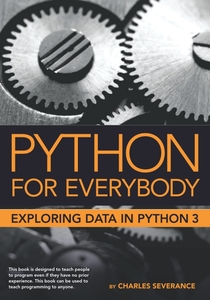
Python for Everybody
"I never seemed to find the perfect data-oriented Python book for my course, so I set out to write just such a book. Luckily at a faculty meeting three weeks before I was about to start my new book from scratch over the holiday break, Dr. Atul Prakash showed me the Think Python book which he had used to teach his Python course that semester. It is a well-written Computer Science text with a focus on short, direct explanations and ease of learning. The overall book structure has been changed to get to doing data analysis problems as quickly as possible and have a series of running examples and exercises about data analysis from the very beginning. Chapters 2--10 are similar to the Think Python book, but there have been major changes. Number-oriented examples and exercises have been replaced with data- oriented exercises. Topics are presented in the order needed to build increasingly sophisticated data analysis solutions. Some topics like try and except are pulled forward and presented as part of the chapter on conditionals. Functions are given very light treatment until they are needed to handle program complexity rather than introduced as an early lesson in abstraction. Nearly all user-defined functions have been removed from the example code and exercises outside of Chapter 4. The word "recursion"1 does not appear in the book at all. In chapters 1 and 11--16, all of the material is brand new, focusing on real-world uses and simple examples of Python for data analysis including regular expressions for searching and parsing, automating tasks on your computer, retrieving data across the network, scraping web pages for data, object-oriented programming, using web services, parsing XML and JSON data, creating and using databases using Structured Query Language, and visualizing data. The ultimate goal of all of these changes is a shift from a Computer Science to an Informatics focus is to only include topics into a first technology class that can be useful even if one chooses not to become a professional programmer."--Open Textbook Library.
See all

Automate the Boring Stuff with Python
If you’ve ever spent hours renaming files or updating hundreds of spreadsheet cells, you know how tedious tasks like these can be. But what if you could have your computer do them for you?In Automate the Boring Stuff with Python, you’ll learn how to use Python to write programs that do in minutes what would take you hours to do by hand—no prior programming experience required. Once you’ve mastered the basics of programming, you’ll create Python programs that effortlessly perform useful and impressive feats of automation to:Search for text in a file or across multiple filesCreate, update, move, and rename files and foldersSearch the Web and download online contentUpdate and format data in Excel spreadsheets of any sizeSplit, merge, watermark, and encrypt PDFsSend reminder emails and text notificationsFill out online formsStep-by-step instructions walk you through each program, and practice projects at the end of each chapter challenge you to improve those programs and use your newfound skills to automate similar tasks.Don’t spend your time doing work a well-trained monkey could do. Even if you’ve never written a line of code, you can make your computer do the grunt work. Learn how in Automate the Boring Stuff with Python.Note: The programs in this book are written to run on Python 3.
See all
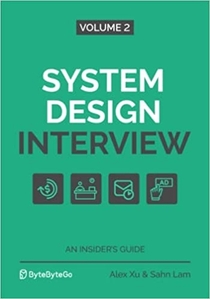
System Design Interview
System Design Interview - An Insider's Guide (Volume 1) System design interviews are the most difficult to tackle of all technical interview questions. This book is Volume 1 of the System Design Interview - An insider's guide series that provides a reliable strategy and knowledge base for approaching a broad range of system design questions. This book provides a step-by-step framework for how to tackle a system design question. It includes many real-world examples to illustrate the systematic approach, with detailed steps that you can follow. What's inside?- An insider's take on what interviewers really look for and why.- A 4-step framework for solving any system design interview question.- 16 real system design interview questions with detailed solutions.- 188 diagrams to visually explain how different systems work. Table Of ContentsChapter 1: Scale From Zero To Millions Of UsersChapter 2: Back-of-the-envelope EstimationChapter 3: A Framework For System Design InterviewsChapter 4: Design A Rate LimiterChapter 5: Design Consistent HashingChapter 6: Design A Key-value StoreChapter 7: Design A Unique Id Generator In Distributed SystemsChapter 8: Design A Url ShortenerChapter 9: Design A Web CrawlerChapter 10: Design A Notification SystemChapter 11: Design A News Feed SystemChapter 12: Design A Chat SystemChapter 13: Design A Search Autocomplete SystemChapter 14: Design YoutubeChapter 15: Design Google DriveChapter 16: The Learning Continues
See all
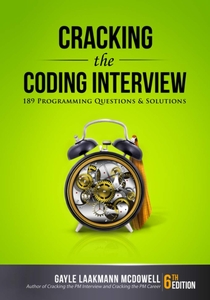
Cracking the Coding Interview
I am not a recruiter. I am a software engineer. And as such, I know what it's like to be asked to whip up brilliant algorithms on the spot and then write flawless code on a whiteboard. I've been through this as a candidate and as an interviewer. Cracking the Coding Interview, 6th Edition is here to help you through this process, teaching you what you need to know and enabling you to perform at your very best. I've coached and interviewed hundreds of software engineers. The result is this book. Learn how to uncover the hints and hidden details in a question, discover how to break down a problem into manageable chunks, develop techniques to unstick yourself when stuck, learn (or re-learn) core computer science concepts, and practice on 189 interview questions and solutions. These interview questions are real; they are not pulled out of computer science textbooks. They reflect what's truly being asked at the top companies, so that you can be as prepared as possible. WHAT'S INSIDE? - 189 programming interview questions, ranging from the basics to the trickiest algorithm problems. - A walk-through of how to derive each solution, so that you can learn how to get there yourself. - Hints on how to solve each of the 189 questions, just like what you would get in a real interview. - Five proven strategies to tackle algorithm questions, so that you can solve questions you haven't seen. - Extensive coverage of essential topics, such as big O time, data structures, and core algorithms. - A behind the scenes look at how top companies like Google and Facebook hire developers. - Techniques to prepare for and ace the soft side of the interview: behavioral questions. - For interviewers and companies: details on what makes a good interview question and hiring process.
See all
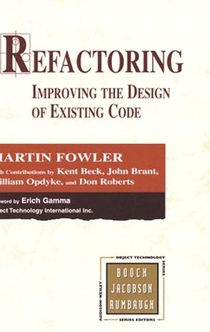
Refactoring
As the application of object technology--particularly the Java programming language--has become commonplace, a new problem has emerged to confront the software development community. Significant numbers of poorly designed programs have been created by less-experienced developers, resulting in applications that are inefficient and hard to maintain and extend. Increasingly, software system professionals are discovering just how difficult it is to work with these inherited, "non-optimal" applications. For several years, expert-level object programmers have employed a growing collection of techniques to improve the structural integrity and performance of such existing software programs. Referred to as "refactoring," these practices have remained in the domain of experts because no attempt has been made to transcribe the lore into a form that all developers could use. . .until now. In Refactoring: Improving the Design of Existing Code, renowned object technology mentor Martin Fowler breaks new ground, demystifying these master practices and demonstrating how software practitioners can realize the significant benefits of this new process. With proper training a skilled system designer can take a bad design and rework it into well-designed, robust code. In this book, Martin Fowler shows you where opportunities for refactoring typically can be found, and how to go about reworking a bad design into a good one. Each refactoring step is simple--seemingly too simple to be worth doing. Refactoring may involve moving a field from one class to another, or pulling some code out of a method to turn it into its own method, or even pushing some code up or down a hierarchy. While these individual steps may seem elementary, the cumulative effect of such small changes can radically improve the design. Refactoring is a proven way to prevent software decay. In addition to discussing the various techniques of refactoring, the author provides a detailed catalog of more than seventy proven refactorings with helpful pointers that teach you when to apply them; step-by-step instructions for applying each refactoring; and an example illustrating how the refactoring works. The illustrative examples are written in Java, but the ideas are applicable to any object-oriented programming language.
See all

Introduction to Algorithms
Some books on algorithms are rigorous but incomplete; others cover masses of material but lack rigor. Introduction to Algorithms uniquely combines rigor and comprehensiveness. The book covers a broad range of algorithms in depth, yet makes their design and analysis accessible to all levels of readers. Each chapter is relatively self-contained and can be used as a unit of study. The algorithms are described in English and in a pseudocode designed to be readable by anyone who has done a little programming. The explanations have been kept elementary without sacrificing depth of coverage or mathematical rigor.The first edition became a widely used text in universities worldwide as well as the standard reference for professionals. The second edition featured new chapters on the role of algorithms, probabilistic analysis and randomized algorithms, and linear programming. The third edition has been revised and updated throughout. It includes two completely new chapters, on van Emde Boas trees and multithreaded algorithms, substantial additions to the chapter on recurrence (now called "Divide-and-Conquer"), and an appendix on matrices. It features improved treatment of dynamic programming and greedy algorithms and a new notion of edge-based flow in the material on flow networks. Many new exercises and problems have been added for this edition. As of the third edition, this textbook is published exclusively by the MIT Press.
See all

Programming Pearls
When programmers list their favorite books, Jon Bentley’s collection of programming pearls is commonly included among the classics. Just as natural pearls grow from grains of sand that irritate oysters, programming pearls have grown from real problems that have irritated real programmers. With origins beyond solid engineering, in the realm of insight and creativity, Bentley’s pearls offer unique and clever solutions to those nagging problems. Illustrated by programs designed as much for fun as for instruction, the book is filled with lucid and witty descriptions of practical programming techniques and fundamental design principles. It is not at all surprising that Programming Pearls has been so highly valued by programmers at every level of experience. In this revision, the first in 14 years, Bentley has substantially updated his essays to reflect current programming methods and environments. In addition, there are three new essays on testing, debugging, and timing set representations string problems All the original programs have been rewritten, and an equal amount of new code has been generated. Implementations of all the programs, in C or C++, are now available on the Web. What remains the same in this new edition is Bentley’s focus on the hard core of programming problems and his delivery of workable solutions to those problems. Whether you are new to Bentley’s classic or are revisiting his work for some fresh insight, the book is sure to make your own list of favorites.
See all
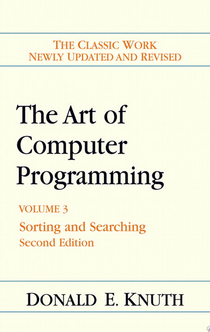
The Art of Computer Programming
The bible of all fundamental algorithms and the work that taught many of today's software developers most of what they know about computer programming. —Byte, September 1995 I can't begin to tell you how many pleasurable hours of study and recreation they have afforded me! I have pored over them in cars, restaurants, at work, at home... and even at a Little League game when my son wasn't in the line-up. —Charles Long If you think you're a really good programmer... read [Knuth's] Art of Computer Programming... You should definitely send me a resume if you can read the whole thing. —Bill Gates It's always a pleasure when a problem is hard enough that you have to get the Knuths off the shelf. I find that merely opening one has a very useful terrorizing effect on computers. —Jonathan Laventhol The first revision of this third volume is the most comprehensive survey of classical computer techniques for sorting and searching. It extends the treatment of data structures in Volume 1 to consider both large and small databases and internal and external memories. The book contains a selection of carefully checked computer methods, with a quantitative analysis of their efficiency. Outstanding features of the second edition include a revised section on optimum sorting and new discussions of the theory of permutations and of universal hashing.
See all

Code Complete, 2nd Edition
Widely considered one of the best practical guides to programming, Steve McConnell s original CODE COMPLETE has been helping developers write better software for more than a decade. Now this classic book has been fully updated and revised with leading-edge practices-and hundreds of new code samples-illustrating the art and science of software construction. Capturing the body of knowledge available from research, academia, and everyday commercial practice, McConnell synthesizes the most effective techniques and must-know principles into clear, pragmatic guidance. No matter what your experience level, development environment, or project size, this book will inform and stimulate your thinking-and help you build the highest quality code.
See all

The Mythical Man-Month
Few books on software project management have been as influential and timeless as The Mythical Man-Month. With a blend of software engineering facts and thought-provoking opinions, Fred Brooks offers insight for anyone managing complex projects. These essays draw from his experience as project manager for the IBM System/360 computer family and then for OS/360, its massive software system. Now, 20 years after the initial publication of his book, Brooks has revisited his original ideas and added new thoughts and advice, both for readers already familiar with his work and for readers discovering it for the first time. The added chapters contain (1) a crisp condensation of all the propositions asserted in the original book, including Brooks' central argument in The Mythical Man-Month: that large programming projects suffer management problems different from small ones due to the division of labor; that the conceptual integrity of the product is therefore critical; and that it is difficult but possible to achieve this unity; (2) Brooks' view of these propositions a generation later; (3) a reprint of his classic 1986 paper "No Silver Bullet"; and (4) today's thoughts on the 1986 assertion, "There will be no silver bullet within ten years."
See all

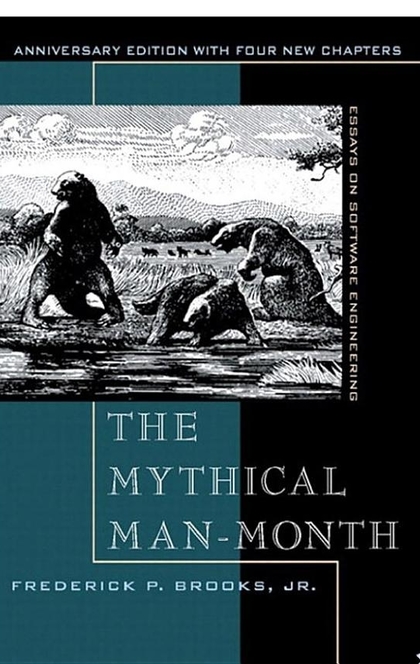








Comments